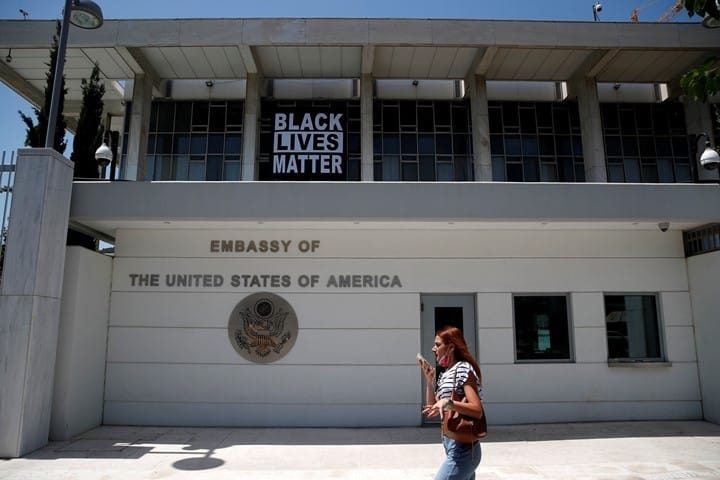
U.S. embassies around the world may fly the flag of Black Lives Matter (BLM), commemorating the death of George Floyd, according to a memo sent to embassies by Secretary of State Antony Blinken last week, revealed conservative magazine Human Events News on Monday.
Floyd was killed a year ago today, on May 25, and now the promotion of the BLM narrative on “racial justice” and “systemic racism,” following the “brutal murder” is presumably being incorporated into official U.S. diplomatic policy.
The memo — part “woke” statement on social justice, part apology for U.S. “systemic racism,” part endorsement of all BLM materials — expressly encourages the display of the BLM flag or banner at U.S. facilities (except on the actual flagpole that holds the American flag).
Despite the documented criminal actions of BLM protestors during the riots of 2020, and despite the organization’s declining popularity with American voters, the federal government has nonetheless endorsed and promoted an organization with admitted Marxist roots that also has ties to China through a Chinese community advocacy organization.
The memo is directly pursuant to President Joe Biden’s “Executive Order on Advancing Racial Equity,” issued on January 20. This effort is named a top priority for the administration’s domestic and foreign policy and noted that the United States cannot credibly message on human rights abroad if it does not address these same issues at home.
The State Secretary also provides an “official” background of BLM that is described as a “social movement [that] gained prominence following a series of high-profile killings of Black Americans in 2013 and 2014 … The movement appears to have begun organically on social media. The phrase ‘Black Lives Matter’ then became a rallying cry for protesters and organizations seeking to raise awareness of, and respond to, issues associated with racism in the United States. BLM is thus an umbrella term for a constellation of ideas, objectives, and groups.”
The memo encourages the use of “Black Lives Matter language in diplomatic engagements, such as in messaging content, speeches, and other diplomatic engagements with foreign audiences to advance racial equity on May 25 and beyond, as well as posts to focus on the need to “eliminate systemic racism and its continued impact.”
Further, the memo specifies how to display a BLM banner properly. The Chef of Mission may choose to install BLM-related displays within the interior of the mission, or exterior displays other than the display of a BLM flag on the flagpole, as appropriate and depending on local context. This cable constitutes a blanket-written authorization for calendar year 2021. The BLM flag, and/or any other types of affinity flags, should be treated as pennants of societies.
The paragraph “Action required” says the diplomatic posts are strongly encouraged to make full use of department and interagency tools and resources to promote policy objectives to advance racial equity and support for underserved communities throughout the year, including with a particular focus on May 25 and during June to commemorate Juneteenth and lesser-known racially motivated attacks such as the Tulsa Race Massacre — the 100th anniversary of which will take place May 31-June 1, 2021.
It also says that Global Public Affairs (GPA) within the State Department will release a compilation video featuring messages from activists around the world on the importance of global racial justice as part of a playbook with language for the anniversary of Floyd’s murder. This video compilation will also feature senior department leaders to demonstrate the administration’s commitment to racial equity and support for underserved communities.
The message of BLM is a little hard to pin down, beyond the “anti-racist” line its supporters’ spout. Critics have alternately described BLM as “anti-white,” “Marxist,” “anti-police,” and “anarchist” — the latter designation used by both critics and supporters alike. Confusion aside, the organization’s goals are apparently so inseparable from the official policy of the White House, that the State Department is taking them worldwide.
Blinken’s memo will come as no surprise to anyone who watched Biden and Vice President Kamala Harris ride into the Oval Office championing the BLM cause — with Harris in particular declaring that the group’s often-violent protests “are not going to stop after election day … and should not stop.” Corporate America has forked out billions to the movement, and the country’s largest companies issued fawning statements in support, even as BLM rioters looted their stores.
Herein lies one of many contradictions of the Biden-BLM alliance. BLM’s existence is predicated on the belief that America is “systemically racist,” and its political, legal, and social institutions work to oppress people of color. Yet this very “oppressed” part of America is represented abroad by the State Department. Either BLM is lying about the existence of systemic racism, or the State Department is lying about its commitment to end it.
Either way, it’s hard to imagine foreigners seeing a BLM flag hoisted outside an American embassy as anything but virtue signaling on a global level.



